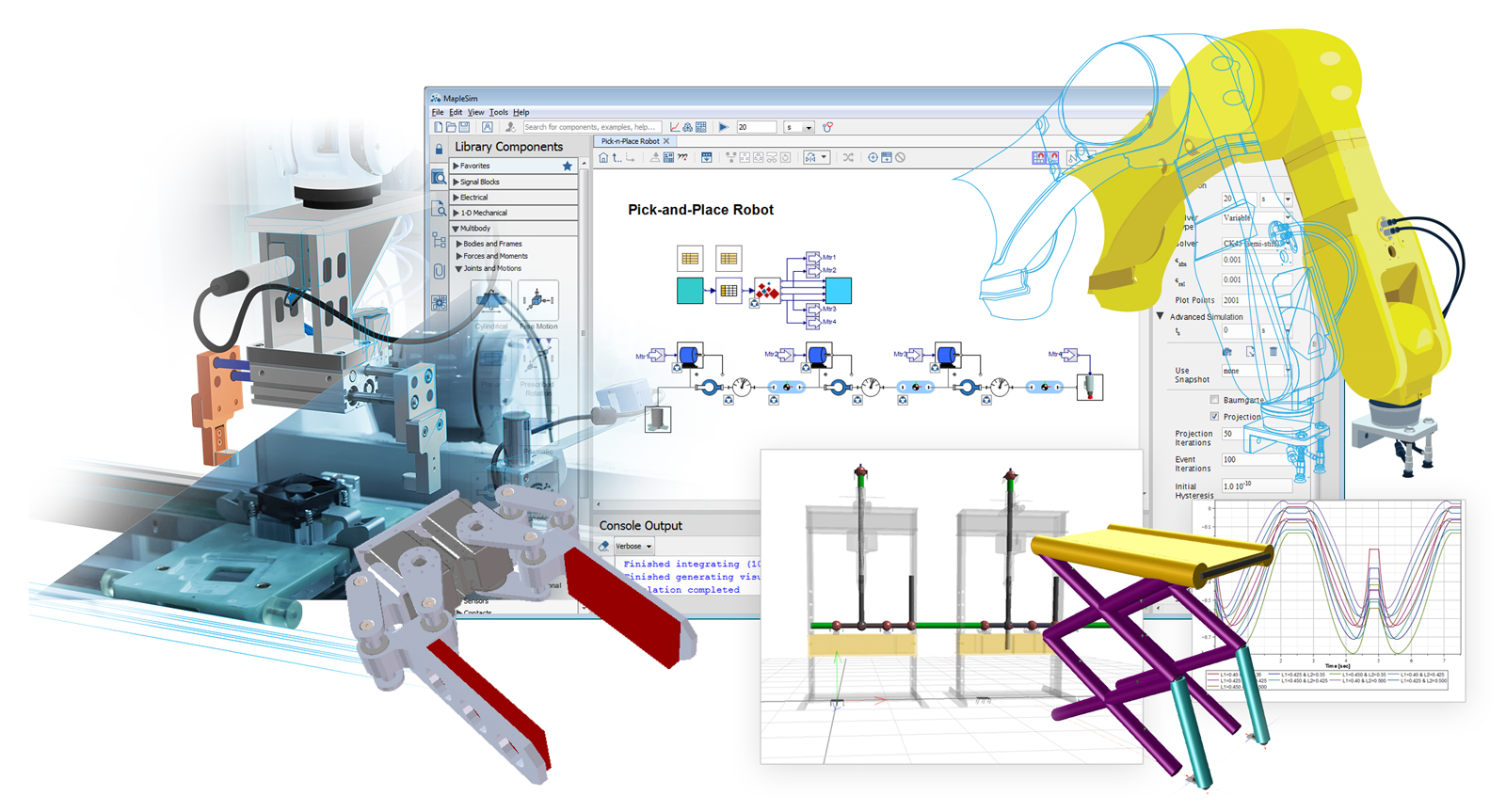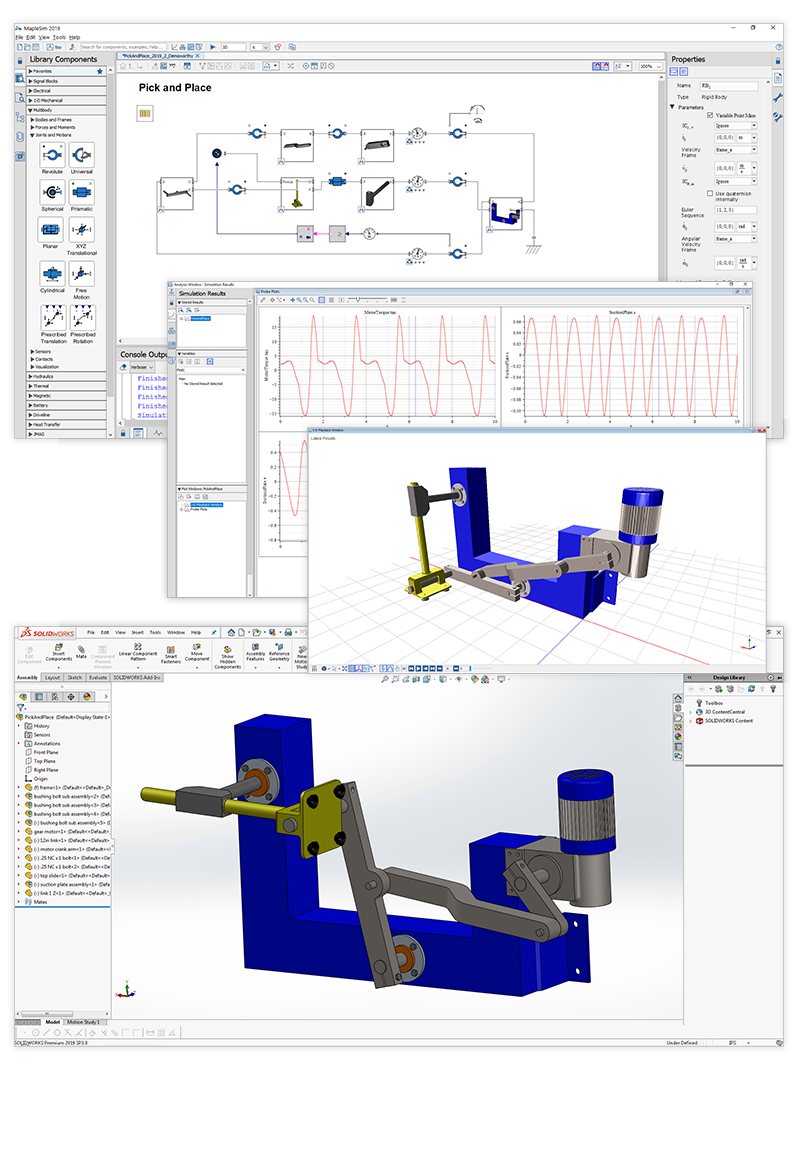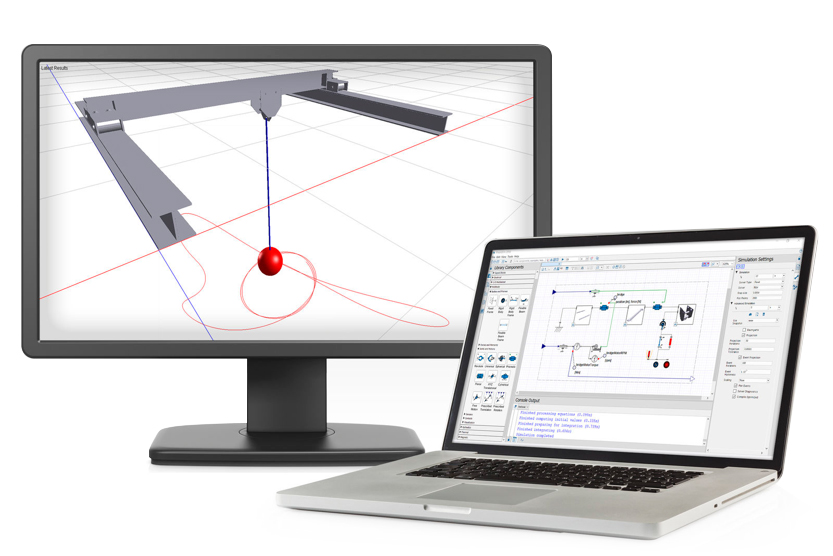Improved Performance
New sophisticated algorithms for model processing and constraint handling provide further improvements to performance.
- Many simulations now run faster due to sophisticated constraint handling in the model, which reduces the overall number of constraints that need to be monitored during the simulation by capturing the same constraints in fewer mathematical equations.
- All exported models, including those created using the MapleSim Connector for FMI and the MapleSim Connector for connectivity with Simulink, take advantage of the same simulation improvements, and so run faster on the target platform.
- For large models, the model formulation stage takes significantly less time because the index reduction process is now more efficient.
New and Improved Apps
MapleSim Apps are easy-to-use tools for model creation and analysis. New and improved apps in MapleSim are especially useful for machine design and automation projects.
- New Cam Generation App: This app makes it very easy to create custom components that model the kinematic behavior of your cams and their followers, and then incorporate them into your model. You can define shape, direction of motion, speed, and more, and visualize behavior with plots of velocity, acceleration, and jerk.
- Improved 1-D Motion Generation App: It is now easy to synchronize motion profiles with one another, and easy to view the peak values of a segment for velocity, acceleration, jerk, and power.

MapleSim CAD Toolbox
With the MapleSim CAD Toolbox, an add-on to MapleSim, you can see how your mechanical CAD models will behave as part of a larger, multidomain system, and apply MapleSim's advanced analysis tools to improve your designs. This toolbox makes it easy to import CAD models into MapleSim, automatically capturing the kinematic and kinetic properties of the model components. As part of the MapleSim 2019.2 release, this toolbox provides substantial enhancements to the workflow, interface, and simulation engine when working with CAD models. Improvements include:
- Importing a CAD diagram into MapleSim is faster, especially for large models.
- If you change the CAD diagram and re-import it into MapleSim, any coordinates you defined after the first import will be adjusted with the parts they are connected to, eliminating the need to adjust them by hand.
- MapleSim will automatically group rigidly attached parts on import from many popular CAD systems, so you no longer need to make all these associations manually.
- Large models are significantly more responsive to manipulation, such as rotation or panning through the model diagram.
- The toolbox has been updated to support the most recent releases of many popular CAD tools, including Autodesk Inventor®, CATIA®, SOLIDWORKS®, NX®, and more. In addition, the toolbox now supports new formats, enabling it to be used with even more CAD tools. These include AutoCAD® 3D, I-deas®, STEP/XML, and others.
- The simulation engine offers more numerically robust handling of kinematic constraints coming from the CAD models, so the simulation is more likely to work the first time without further adjustments.

MapleSim Connector for FMI
The MapleSim Connector for FMI, a separate connector add-on, enables you to share high-fidelity, multidomain models created in MapleSim with many other modeling tools using the FMI standard.
- In addition to the simulation speed increases coming from the improved constraint handing, models exported as FMUs have further improvements to simulation speed due to more efficient handling of variables.
- You can now choose between minimal and extended variable tracking during the simulation, providing further performance improvements once the additional tracking is no longer needed for analysis, optimization, or debugging reasons.
MapleSim Heat Transfer Library
The MapleSim Heat Transfer Library, available as a separate add-on, gives you a comprehensive view into the heat transfer effects present in your model, enabling you to refine your design to improve performance and avoid overheating. In MapleSim 2019.2, this library includes more built-in geometries for analyzing the temperature distribution of your system-level model.
Improved Performance
Across the board, MapleSim is now faster when it comes to creating, simulating, and analyzing models.
- Simulation is faster due to more efficient handling of constraints when preparing the model, resulting in more compact, faster simulation code without any loss of fidelity. These results mean that MapleSim’s industry-leading speeds have gotten even better, saving time and enabling more real-time applications.
- Exported models run faster, because the code generated during model export takes advantage of the same efficiencies, whether you use the built-in code generators or the specialized add-on connectors for FMI, Simulink®, and others.
- Large models are more responsive during model creation and manipulation, no matter how many components and parameters you are working with. Improvements are especially noticeable when working with large sets of parameters.
Increased Modeling Scope
New built-in and add-on components and expanded support for external libraries means you can create more models, faster.
New Components
Many of the built-in MapleSim component libraries have new components.
- The Hydraulics library includes over 25 new components for restrictions and valves, including directional valve controls. The overall formulation has also been updated to provide greater numerical stability for real-time simulations.
- The Electrical library provides new multiphase sensors, more signals blocks and power convertors, and the Spice3 library from Modelica® for easier integration of SPICE-based models into MapleSim.
- In addition to the revolutionary multibody modeling technology built into MapleSim, MapleSim now also supports the Modelica Multibody Library, so multibody models built in the Modelica library can be easily brought into MapleSim.
- MapleSim supports the Modelica Synchronous Library, so these components can be easily brought into MapleSim for greater flexibility with real-time simulations.
- MapleSim is now based on the Modelica Standard Library 3.2.3, taking advantage of the most recent release throughout the product.
- The MapleSim Heat Transfer Library add-on has over 15 new components that define new geometries, boundaries, and visualizations.
New Product! MapleSim Engine Dynamics Library™ from Modelon
The MapleSim Engine Dynamics Library from Modelon provides specialized tools for modeling, simulating, and analyzing the performance of combustion engines. This add-on component library is especially useful for representing transient engine responses, and can be used for analyzing engine performance, performing emission studies, controls development, hardware-in-the-loop verification of vehicle electronic control units, and more.
- Capture fluid mechanics, thermal dynamics, air gas exchange dynamics, and mechanics of your combustion engine, all in single modeling tool.
- Simplify your control design projects, including transient engine responses and hardware-in-the-loop verification of vehicle electronic control units (ECUs).
- Analyze exhaust flow paths, intercoolers, turbochargers, and Exhaust Gas Recirculation (EGL) loops.
- Build your models easily using a wide range of components, including cylinders, turbochargers, heat exchangers, sensors, flow modifiers, and more.
Even More Connectivity
MapleSim 2019 further enhances the extensive connectivity options for integrating MapleSim with the rest of your toolchain.
- You have more simulation options when running models imported from other systems, as imported FMUs can now be run using MapleSim’s variable-step solvers, as well as the fixed step solvers.
- The MapleSim FMI Connector add-on has been expanded to support FMI 2.0 Variable-Step Co-Simulation on export, allowing you to easily export your MapleSim model to another tool using either variable step or fixed step solvers, as is most appropriate for your application.
- Improved interactive analysis apps for Monte Carlo analysis, Optimization, and Parameter Sweeps now allow you to export your results, including visualizations, to CSV files for use in Excel® and other tools.
New Product! B&R MapleSim Connector
The new B&R MapleSim Connector add-on gives automation projects a powerful, model-based ability to test and visualize control strategies from within B&R Automation Studio, and to export simulation data for motor, servo, and gearbox sizing within SERVOsoft®. Beginning with your machine’s CAD information, you can easily create a MapleSim model that simulates the dynamics of your design, and you can run these simulations from within B&R Automation Studio.
- Use your CAD files to create accurate, dynamic machine models within MapleSim to simulate the precise torque and loading responses of your design.
- Export the MapleSim model results to SERVOsoft to quickly match your loading requirements to available motors and servo drives.
- Import the MapleSim model and CAD visualization directly into B&R Automation Studio to test control code against the model and view 3-D visualizations of your machine operation.













